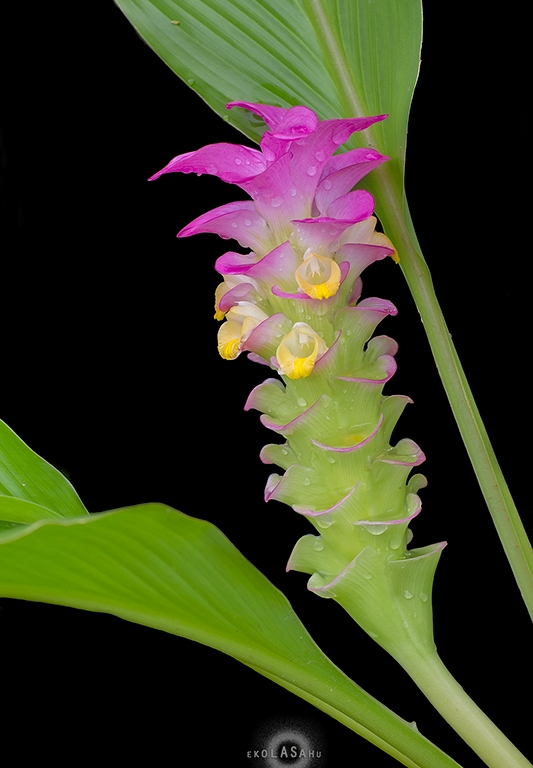Laos holds many wonders for those naturally inclined; I recently visited a small patch of forest not too far from Vientiane, and came across several of these beautiful Curcuma cf. cordata plants. I believe them to be native, because these plants have been observed in at least one other forest in Laos. Here are a couple of photographs of the gorgeous flowers I saw.

The forest was more of a swamp when I visited (in July 2014), with most of it underwater at the time. I followed a trail and a stream leading into the forest, and found several of these plants along the trail. All the plants I saw were in bloom, with the flowers being about 8 to 10 inches tall. I smelt a few of them, and the white and yellow parts that are technically the “true flowers” were mildly fragrant. The pink and green petal-like structures that form the bulk of the bloom are actually specialised leaves known as bracts.

There seems to be some confusion regarding the classification of this species and C. petiolata. Some sources suggest that the names are synonomic, while others do not. For the time being, I am led to believe that the two are distinct, and that this is Curcuma cordata (I beg correction if I’m wrong). In either case, this species is a member of the Zingiberaceae, or the ginger family. It is also known as the “Jewel of Thailand”, and is a native of Thailand, Laos and Malaysia.
It is popular among gardeners and flower enthusiasts for its ornamental value. Judging by the nature of the place where I found these, they seem to thrive in very wet soil and under heavy shade, not unlike most other Zingiberaceae. If I had a garden, I would very much like to have a few of these lovely plants, with their glossy leaves and subtly beautiful flowers.
References:
- Encyclopedia of Life, (n.d.). Descriptions and articles about Curcuma petiolata – Encyclopedia of Life. [online] Available at: http://eol.org/pages/1122300/details [Accessed 28 Jul. 2014].
- Kato, M., Kosaka, Y., Kawakita, A., Okuyama, Y., Kobayashi, C., Phimminth, T. and Thongphan, D. (2008). Plant-pollinator interactions in tropical monsoon forests in Southeast Asia. American Journal of Botany, [online] 95(11), pp.1375-1394. Available at: http://www.amjbot.org/content/95/11/1375.full.pdf+html.
- Kuehny, J., Sarmiento, M. and Branch, P. (2002). Cultural studies in ornamental ginger. Trends in new crops and new uses, pp.477–482. Available at: https://www.hort.purdue.edu/newcrop/ncnu02/pdf/kuehny.pdf
- Plantnames.unimelb.edu.au, (2001). M.M.P.N.D. – Sorting Curcuma names. [online] Available at: http://www.plantnames.unimelb.edu.au/Sorting/Curcuma.html [Accessed 28 Jul. 2014].
- Ravindran, P., Nirmal Babu, K. and Sivaraman, K. (2007). Turmeric. 1st ed. Boca Raton, FL: CRC Press.
Like Bald Guy With a Camera’s photography? See more of his work here.



Aloke, I must say without any exaggeration or flattery this blog is superb in terms of the variety, information and language. Keep it up!
LikeLiked by 1 person